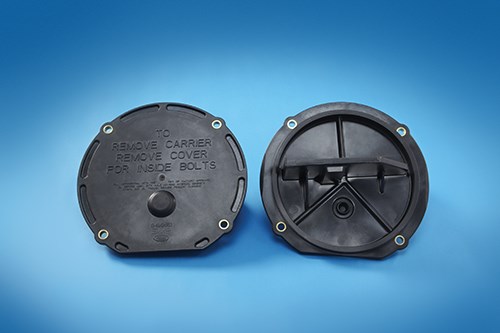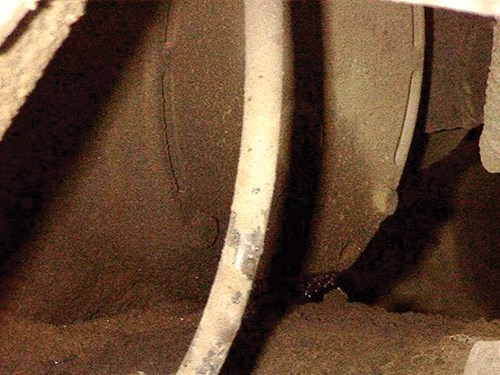Composites for heavy truck: Tough-duty inspection cover
Thermoplastic composite reduces weight, cost, corrosion, extends maintenance intervals.
As they have in passenger cars and light trucks, reinforced plastics are gaining ground in underhood and powertrain applications on commercial trucks. Progress, however, has been slower because the abuses to which big trucks are subject — heat, aggressive chemicals and, in some cases, stone impacts — are far greater. Further, these vehicles are operated orders of magnitude more miles/kilometers per year and have service lives that can stretch to decades. Despite these challenges, truck OEMs, like automakers, face increasingly tough fuel-efficiency and emissions standards and (this comes as no surprise) the features that make composites attractive for passenger vehicles — lower cost and mass, opportunities for parts consolidation, corrosion resistance and noise-damping characteristics — have the same allure for heavy trucks. Another benefit, lower tooling investment, has even greater impact on the big-truck bottom line because parts are larger and build volumes are far smaller, giving composites a cost advantage vs. metals at most production volumes.
Although thermoset composites made the first inroads into heavy trucks, forming valve covers, timing-chain covers, oil pans and intake manifolds, more impact-resistant and more quickly processed thermoplastic composites are now claiming a share. An excellent example is the transaxle inspection cover assembly on CRD 150/1 drive axles produced by American Axle Manufacturing Inc. (Detroit, Mich.) for Mack Trucks Inc.’s (Greensboro, N.C.) tandem-axle line-haul, refuse, dump and mixer trucks (sold under the Pinnacle, Granite, TerraPro, and Titan badges). The two-piece assembly (one assembly per axle) comprises a cover with four molded inserts, plus a magnet (which pulls metal shavings out of the transaxle fluid and is bonded in a later step).
The part is injection molded by Sturgis Molded Products (SMP, Sturgis, Mich.) using 55 percent short-glass-and-mineral-reinforced Reny PA-MXD6 aromatic polyamide (PA) from Mitsubishi Engineering-Plastics Corp. (Tokyo, Japan). It replaced a multipiece cast aluminum assembly (which had replaced one of machined steel) and reduces piece price by 20 percent and weight by 40 percent (from 3.8 lb/1.72 kg to 2.2 lb/1.0 kg). It was hailed as the first thermoplastic transmission cover for heavy industry.
The application that almost didn’t happen
Interestingly, this all-thermoplastic breakthrough didn’t make it into production on the first go-around. At that time, SMP was working with a different customer who was then American Axle’s Tier 2 source for the inspection cover. “We had been working with the cover assembly supplier for about 14 months, looking at different types of materials and prototyping them,” explains Christopher J. Emery, SMP’s VP, sales and marketing. But just as SMP established that the Reny polyamide could meet the application’s demanding requirements, the aluminum supplier for the existing part learned that the new thermoplastic prototype had passed muster in testing and could offer a less-expensive solution. “The cost of the incumbent die-cast material suddenly became much lower,” Emery recalls wryly, “which essentially wiped out the benefit of switching from metal to plastics.” Accordingly, that customer shelved the application and stayed with aluminum.
“Despite the disappointment we felt,” Emery notes, “we knew this was a winning application.” For that reason, he kept in touch with Mack. Nothing happened for about two-and-a-half years, but then: “Out of the blue, one day, I got a call from Mack’s purchasing department, asking if we were still interested in pursuing this application.”
Emery and his team soon learned that the original Tier 2 supplier had lost American Axle’s business and the new Tier 2 was quite keen to explore alternative materials. “Of course, plastic doesn’t corrode,” adds Emery, “so going into this a second time, we knew we had more to offer the project.”
Indeed, that phone call kicked off a new program. Although SMP had spent more than a year on research with the first Tier 2, the company redesigned, prototyped, validated via a battery of tests, and then rolled out a thermoplastic composite cover for the new Tier 2 in less than 20 weeks.
Tough-duty testing
That does not mean the roll-out was easy. The part had to meet very challenging validation requirements. And although SMP conducted dimensional analyses at its in-house metrology lab, all testing was done by the Tier 2 and, ultimately, by the OEM. To meet the modified Society of Automotive Engineers (SAE, Warrendale, Pa.) J400 spec, for example, the cover had to survive gravel bombardment at -40 oF and at 300oF (-40 oC and 149oC). In this test, some leakage is inevitable, but the cover must not crack or leak more than 279 cm3/min (0.7 gal/min) at 5 psi/35 KPa (no more than had leaked from the aluminum cover). It also had to pass a 24-hour thermal cycling test (modified SAE J1455), which involved 6 hours at -40oF/-40oC, followed by 14 hours at 250oF/ 121oC and then 15 minutes at a peak of 300oF/149oC. The covers were tested with O-rings (70 durometer, ASTM:3CH 720 A25 B14 E16 E36) and, again, could not leak more than 279 cm3/min at 5 psi. Tests also included chemical compatibility with transmission fluids (Bulldog 80W90 and Emgard EP75W90 types) and dimensional integrity to ensure the cover didn’t leak and that it would provide easy access to the transaxle. For the latter, the assemblies were subjected to six removals and remounts with both iron and aluminum fixtures, during which the covers could show no warp or bushing wear. Lastly, they had to pass accelerated field tests on vehicles, during which they were subjected to hot/cold temperature cycling and onroad driving. Reportedly, critical part dimensions for composite covers were held to ± 0.007mm (± 0.0003 inch) with no warpage.
Beyond weight and cost savings, the composite assembly also provides tighter tolerance control, reducing leaks vs. its aluminum predecessor. Much credit for this advantage can be attributed to the selection of the aromatic polyamide. It is known for its high glass-transition temperature (Tg) of 469oF/243oC, high stiffness and strength, chemical stability, and long-term creep resistance — features vital for a tough-duty application on vehicles with long service lives. Going into the program, the supply team knew that long-term compression, deformation and warpage that might occur between attachment bolts were absolutely unacceptable, because each fault could permit leakage and, therefore, would necessitate adding bolts (and cost) to secure a tighter seal, something the tier supplier wanted to avoid. Although PA 6 and 6/6 polymers have a penchant for absorbing water and swelling, the aromatic grade’s polymer backbone reportedly presents fewer attachment sites for water molecules, and, therefore, is less prone to moisture uptake and resulting dimensional change. In fact, the resin exhibits less than 2 percent elongation over time and is said to offer creep resistance that is superior to that offered by PA 6, 6/6, and more exotic PA 12, eliminating cover-to-transaxle-housing gaps between fastener locations. Additionally, the chemical structure of the resin promotes good flow at lower injection pressures during the molding process. This facilitates precise molding even when part wall thickness varies between 2 and 8 mm (0.8 and 0.3 inch) along the same flow path.
Great, but could be even better
In production since July 2006, the cover reportedly has netted Mack Trucks Inc. additional savings on freight and fuel-cost savings for operators, due to its reduced mass. Unlike the metal versions, the composite cover’s bushings are insert-molded, which eliminates the need for the postmold hole drilling and tapping operations that otherwise would be necessary for two bolts that are now no longer needed. Additionally, the corrosion-free aromatic polyamide eliminates red rust, an issue with the original steel cover. Further, service of the assembly is said to be easier because the lighter cover requires less force to remove and replace. And the composite’s noise-damping properties make for a quieter transmission without the use of secondary sound-abatement components, which would increase assembly cost.
That said, the cover project could have yielded even greater benefits. Although a few modifications were allowed, for the most part, SMP and Mitsubishi were stuck with a cover geometry that had been optimized for metals. The design, therefore, couldn’t take full advantage of the composite’s capabilities. For example, the new cover does feature an integrally molded oil-drip pan — previously a separate component that directs the flow of transmission fluid over the magnet — and the critical O-ring seal seat (channel) is molded in. However, the magnet is still attached in a separate operation, when it could easily have been insert molded. The O-ring, added in a secondary step, also offers the possibility, under the right conditions, of being molded-in.
As impressive as the part is, and as significant as the weight savings that the thermoplastic was able to deliver, “there still are plenty of ways we could take further weight out of the assembly,” Matthew Orlando, Mitsubishi’s business development director, concludes, “if we had the opportunity to redesign it from scratch.”
Related Content
Natural fiber composites: Growing to fit sustainability needs
Led by global and industry-wide sustainability goals, commercial interest in flax and hemp fiber-reinforced composites grows into higher-performance, higher-volume applications.
Read MoreTU Munich develops cuboidal conformable tanks using carbon fiber composites for increased hydrogen storage
Flat tank enabling standard platform for BEV and FCEV uses thermoplastic and thermoset composites, overwrapped skeleton design in pursuit of 25% more H2 storage.
Read MoreCryo-compressed hydrogen, the best solution for storage and refueling stations?
Cryomotive’s CRYOGAS solution claims the highest storage density, lowest refueling cost and widest operating range without H2 losses while using one-fifth the carbon fiber required in compressed gas tanks.
Read MoreThe potential for thermoplastic composite nacelles
Collins Aerospace draws on global team, decades of experience to demonstrate large, curved AFP and welded structures for the next generation of aircraft.
Read MoreRead Next
VIDEO: High-volume processing for fiberglass components
Cannon Ergos, a company specializing in high-ton presses and equipment for composites fabrication and plastics processing, displayed automotive and industrial components at CAMX 2024.
Read More“Structured air” TPS safeguards composite structures
Powered by an 85% air/15% pure polyimide aerogel, Blueshift’s novel material system protects structures during transient thermal events from -200°C to beyond 2400°C for rockets, battery boxes and more.
Read MoreDeveloping bonded composite repair for ships, offshore units
Bureau Veritas and industry partners issue guidelines and pave the way for certification via StrengthBond Offshore project.
Read More
.jpg;width=70;height=70;mode=crop)


















.jpg;maxWidth=300;quality=90)









